| |
Sony MVC-CD1000
(NOTE: This camera is not in stores yet.
Projected ship date is early August, 2000)
Page 5. Mavica MVC-CD1000 Features & Tour |
 |
General Camera Features
The close resemblance between Sony's new FD95 Mavica and the just-announced CD1000 is no accident: Rather than build a new camera from the ground up around the CD-R technology (but can that be far behind?), Sony engineers instead opted to simply graft the new CD-R drive onto an existing design. Thus, the body, controls, camera electronics, and most operating menus on the CD1000 are identical to those of the FD-95.
Here's a list of camera features, cribbed from our forthcoming full review of the FD-95:
- 2.1 megapixel, 1/3 inch CCD delivering up to 1600 x 1200 resolution images.
- 2.5 inch, color, TFT LCD monitor.
- Smaller, LCD optical viewfinder with data display.
- 10x, 6 to 60mm f/2.8-f/11 lens (equivalent to a 39 to 390mm lens on a 35mm camera.
- 2x digital telephoto.
- Steady Shot option to (dramatically) decrease camera shake.
- Program AE, Aperture Priority, Shutter Priority, Twilight, Twilight Plus, Landscape and Panfocus capture modes.
- Shutter speeds from 8 to 1/500 seconds.
- Automatic, Outdoor, Indoor and One-Push white balance settings.
- Built-in, pop-up flash with Automatic, Red-Eye Reduction, Forced and Suppressed modes and manually controlled intensity settings.
- Spot metering option.
- 10 second self-timer.
- MPEG movie record mode.
- Voice Memo record mode.
- E-Mail and Text (GIF) still image record modes.
- Manual focus option.
- InfoLITHIUM battery system.
To this, add the following features unique to the CD1000:
- 156 Megabyte removable storage on 77mm CD-R media
- Fast ~3.5 second cycle time at full resolution
- Average JPEG compression of only 7:1 (MVC-FD95 average was 18:1)
- Optional uncompressed TIFF file format! (A Mavica first!)
- USB computer connection for high-speed downloads without "finalizing" disks
- Higher-capacity NP-550 InfoLITHIUM battery, to handle higher peak power drain of CD-R
| Let's take a quick walk around the new camera. As you'll see, the controls are essentially identical to the FD95, only the arrangement being different, to make room for the CD-R drive mechanism and electronics (and hinged back for CD access) |
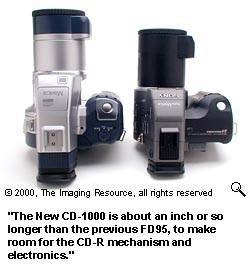 |
| From the front, the view is almost identical to the FD95, although the right side of the new model bulges a bit more, to provide the diameter needed for the CD-R housing. You can't tell in this shot, but the handgrip on the CD1000 is slightly smaller than that on the FD95. The bulge on the left and bottom sides of the lens is for the anti-vibration system used to reduce the effects of camera shake at long telephoto settings. This has been a feature of the top-end Mavicas since the FD91, although we think the Steady Shot system on the new FD95 and CD1000 is considerably more effective. (We haven't been able to test one of the new units side by side with an FD91, this is just our impression based on our recollection of the FD91's performance. |
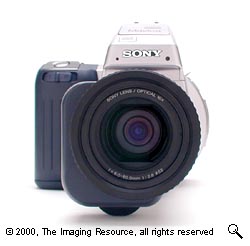 |
| The handgrip side of the camera is quite plain: On the older Mavicas, this is where the opening was for the floppy drive. This view also shows the much-elongated top-mounted viewfinder of the CD1000. The new design is apparently to accommodate control buttons located on the other side. |
 |
| Here we see the left-side controls, and the door latch for the CD-R drive. (The drive lives behind the camera's rear panel.) The Program AE, +/- buttons, and white balance controls have moved up from their positions on the FD95, and now live on the side of the viewfinder assembly. The A/V port has moved down to the bottom, underneath the lens barrel, while the external flash connector from the top of the FD95 has moved to just above the rear cover latch. |
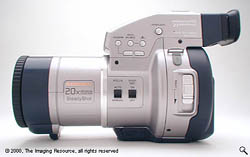 |
| Many of the controls are still on the back of the camera, although they've all moved to above the LCD display screen. The "Display" button turns the information overlay for the LCD viewfinder on and off, while the "LCD" button does the same for the entire rear-panel LCD itself. (The tiny LCD that drives the "optical" viewfinder remains on at all times.) Also back here are controls for speaker volume, flash mode, spot metering, and macro mode. Menu navigation is controlled by a hemispherical rocker toggle control at upper right. The mode dial formerly on the back has moved to the top, and the power on/off switch is now on the right, where the floppy eject button was on the FD95. |
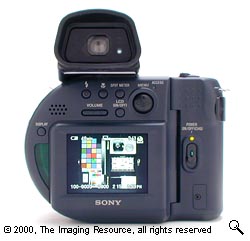
|
| The top of the camera holds the mode control on the right, where it's easily reached by your right thumb. The shutter button is in the usual place, and the microphone has been moved atop the slanting front of the viewfinder assembly. The onboard flash and flash shoe mount round out the complement of top-panel accouterments. |
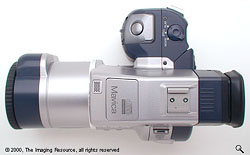 |
| The bottom of the camera holds the battery compartment cover, tripod mount, and (to either side of the tripod mount) side-mounted ports for A/V output and digital I/O (USB). Our one real complaint about the design of the CD1000, shared in common with the FD91 and FD95, is that the bottom really has too little flat area around the tripod socket. (Which at least is made of metal, to give credit where due.) This tiny footprint makes for a very unsteady tripod mount, which is all the more regrettable because it could have so easily been avoided: There's absolutely no reason (other than design aesthetic) for the tripod platform to be so tiny: It could easily have extended at least another half-inch or so in all directions, which would have dramatically improved tripod stability. (I guess we have to find one thing to dislike on every; camera, and this is it for us on the CD-1000. ;) |
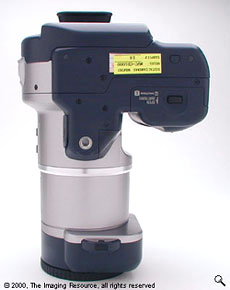 |
| We're not used to providing inside views of cameras we review, this is some kind of a first: Here are two views of the CD compartment, both with and without a CD in place. The entire back of the camera hinges open to provide access to the CD spindle. |
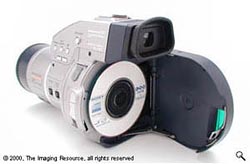 |
| As part of making the CD-R work in a handheld environment, we noticed that the Sony engineers have provided a very compliant mount for the CD: The whole mechanism "floats" on what feels like a stiff rubber suspension system, to reduce the effect of vibration while reading or writing the drive. It's not terribly clear in this shot, but the "floating" portion of the mechanism is the black-colored area on the right side of the compartment. We confess that the drive is the area of our greatest concern on the CD1000: CD-R technology requires fantastically close tolerances and precise head control. It made us a little nervous every time we inserted or removed a CD, with our fingers so close to the lens mechanism. Still, while we weren't overly rough with it (pretty darn cautious, given that this was one of only a few units in the world at the time of our initial testing), we found that the camera seemed to have no problems writing, even with pretty substantial amounts of handheld jiggling during the process. (I mean, we really tried to make it mis-write, but never succeeded, even when knocking it on the top, sides, bottom, and back with our hand while it was writing a file. - Nary a problem.) |
 |
<< Out of the Blue: CD-R in a Camera | Using CD-Rs in the Camera >>
Reader Comments!
So what do you think of the new Sony CD1000? Is it the future of digital? The last of the digicam dinosaurs? Would you buy one? Click here to leave a comment! (Read what's here, then add your own!)
Questions? Problems? Email us!
This document copyright (c) 2000, The Imaging Resource, all rights reserved. Visitors to this site may download this document for local, private, non-commercial use. Individuals who have themselves downloaded this page may print a copy on their personal printers for convenience of reading and reference. Other than this explicit usage, it may not be published, reproduced, or distributed in print or electronic and/or digital media without the express written consent of The Imaging Resource.
|
 |
